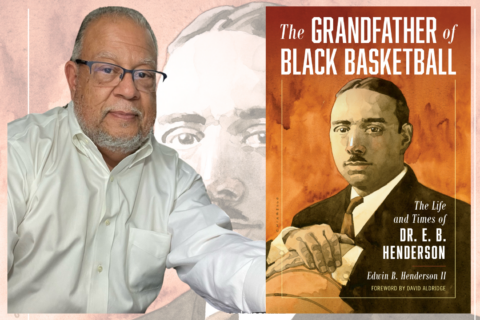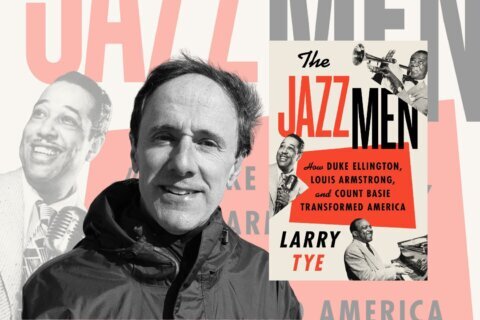This story was written as part of the WTOP Book Report series authored by Terik King. Read more of that coverage.

According to author and cartoonist Brian “Box” Brown, it all started with a Sears catalog.
“I’m interested in these vintage toys and stuff from my youth,” Brown told WTOP. “I remember I bought a Sears catalog from the ’80s to look at the toys. And it creates this feeling in me that’s [a] really, really strong emotion. I just started to think about how toy companies … can utilize this feeling of childhood nostalgia to sell products to adults.”
Brown’s passion for the toys of his youth led to a decadelong journey to understand the connection between these toys and the strong nostalgic feeling he experiences, even in adulthood. He wanted to know why his fellow GenXers continue to be so passionate about such toy brands as “Star Wars,” “My Little Pony” and “He-Man” well into middle age.
The result is his new documentary comic, “The He-Man Effect: How American Toymakers Sold You Your Childhood” (published by First Second Books).
“The He-Man Effect” takes readers on a thought-provoking journey through the capitalistic underpinnings of the most iconic toy brands like the “Masters of the Universe” and “Star Wars” franchises, delving into the intricate relationship between pop culture, nostalgia and societal influence.
From World War I propaganda to Disney’s nostalgia machine
Brown (the author of “André the Giant: Life and Legend,” “Is This Guy for Real? The Unbelievable Andy Kaufman” and “Child Star”) masterfully traces the roots of the nexus between mass-marketing of toys and youth pop culture.
He draws a direct line from World War I propaganda to Disney’s modern-day dominance in the realm of nostalgia-driven entertainment.
“Before there was really advertising for products and stuff, there was wartime propaganda, which was kind of like the first form of advertising to mass groups of people,” he told WTOP, adding that they used repetition as well as visual aids and posters.
Brown’s graphic narrative then moves through time through the evolution of mass media and nascent advertising industry that grew in parallel, tracing advertising on television and in motion pictures, including the notable example of the first Walt Disney motion picture featuring Mickey Mouse. That was in 1928’s “Steamboat Willie,” which was followed by the release of the first Mickey Mouse watch in 1933.
“Walt Disney, especially, understood the power of nostalgia,” Brown says. “And [Disney’s characters] were in movies, which wasn’t as highly regulated in terms of promoting things for children. So that’s why you see, throughout all of this time, Disney toys and stuff. Those that saw Steamboat Willie, those are the parents who took their kids to see Snow White when it came out.”
He reveals how, during the Ronald Reagan era in the 1980s, media deregulation allowed toy companies to seamlessly merge advertising and children’s television.
“That just opened the floodgates,” Brown said. “And it was the first generation of people to experience, as children, basically 24-hour media advertising, because all of the television programs themselves were basically commercials for the toys. And then there were commercials also during the show, so all of the children’s television programming was advertising and it paid off.”

This paved the way for the commercial success of iconic properties like “G.I. Joe” and “Transformers,” ultimately culminating in the birth of “Masters of the Universe.”
In “The He-Man Effect,” Brown combines his genuine passion for pop culture with a sophisticated critique of the systemic issues embedded within geek culture and society at large. This juxtaposition creates a narrative that invites readers to reconsider their own relationship with nostalgia and consumerism.
“It’s good to have memories of your life, and your childhood memories are so precious and powerful because they last forever,” Brown said, “And the idea that it’s co-opted by corporations taints it a little bit. I think there must be some sort of real evolutionary reason for this emotion. And I’m not sure that reason is so we can continue to buy ‘Star Wars’ things as adults and grandfathers.”
A message for future generations
As the book highlights the enduring grip of nostalgia on today’s adults, Brown also contemplates its impact on future generations. He questions the wisdom of perpetuating a cycle of intense love for nostalgic brands, warning against instilling this pattern in future generations.

“I talked to people — 90s kids that are like yeah, ‘Teenage Mutant Ninja Turtles,’ ‘Power Rangers,'” Brown said. “So it’s ongoing.”
There’s also the Barbie movie, which set box office records and reportedly has Mattel planning a slate of 14 more films, many of them based on beloved children’s toys.
“I think this book kind of explains why we’re seeing things like that now,” Brown said.
Brown argues that nostalgia, while a beautiful feeling, often obscures the truth and serves corporate interests.
He challenges readers to look beyond the allure of nostalgia and recognize the influence of amoral capitalism in shaping their interests and identities.
“I don’t think the answer is swear off every Disney product and never buy anything ever again,“ Brown said. “But it’s good to know what’s going on.”
And knowing, as they say, is half the battle.








